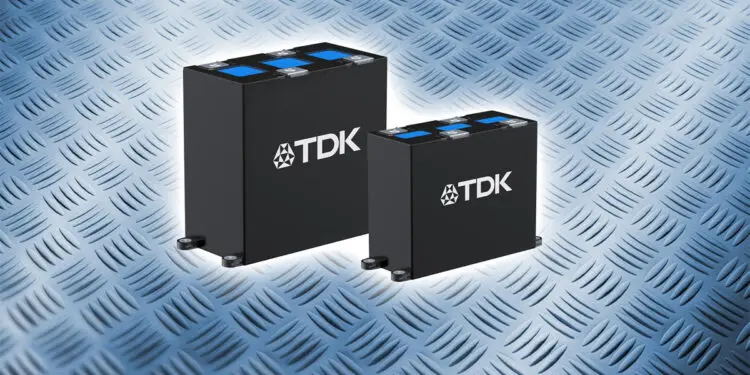TDK Corporation (TSE: 6762) presents ModCap™ − a modular capacitor concept for DC link applications. The newly developed power capacitors are available for rated voltages of 1100 V to 2300 V and cover a 365 µF to 2525 µF capacitance range. The rated currents between 105 A and 180 A are type-conditioned with all types designed for 5 kA recurrent pulse currents. The maximum permitted hot spot temperature is 90 °C.
In contrast to conventional cylindrical designs, the B25645A* capacitor series are cubic in design and available in two versions of either 243 x 169.5 x 90 mm or 258 x 215 x 115 mm. Due to this design, the capacitors can be fitted very close to IGBT modules, thus producing very short lead lengths. This, combined with a very low 14 nH self-inductance of the capacitors, stops any substantial voltage overshooting at the IGBT modules when the current is shut off. As a result, generally no snubber capacitors are needed. This design also makes parallel connections of capacitors easy. Typical applications are compact converters for traction, renewable energies and industrial applications.
The artificial resin-filled plastic housings comply with UL94 V-0. In addition, the fire and smoke formation requirements, in line with IEC 61071, IEC 61881-1, EN 45545-2 HL3 R23, are met. This makes these capacitors well suited for use in trains.
Main applications
- Compact converters for traction
- Renewable energies
- Industrial applications
Main features and benefits
- Modular concept
- Wide voltage range from 1100 V to 2300 V
- Wide capacitance range from 365 µF to 2525 µF
- A maximum 90 °C hot spot temperature
- Qualified according to IEC 61071, IEC 61881-1, EN 45545-2 HL3 R23 regarding fire and smoke formation
- Plastic housing corresponding to UL94 V-0
































